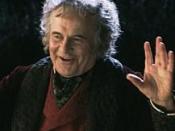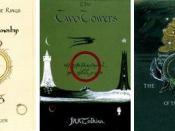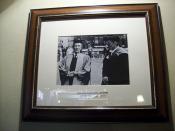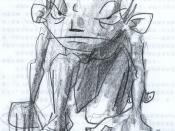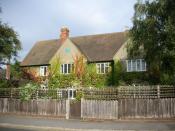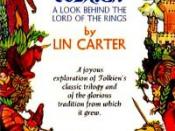Culture in the Works of J. R. R. Tolkien Thesis: The purpose Tolkien had for writing his books was to create mythology for Britain: to have a whole culture through his characters, whether perfect cowards or dashing heroes; music, from simple chants to long elegies; and dragons, his swift-winged entities of power.
I. Characters A. Development 1. Bilbo's journey a. Coward who matures b. Ordinary person who becomes a hero 2. Frodo's journey B. Symbolism 1. Hobbits' meaning 2. Aragron's meaning 3. Tom Bombadil's meaning II. Music A. Development 1. Differences in language 2. Parallel to England 3. Reasons of development B. Instruments III. Dragons A. Causes B. Development 1. Creation a. Worm-like b. Magic 2. Final end a. Had wings b. Hoarded treasure Culture in the Works of J. R. R. TolkienJ. R. R. Tolkien's books, from the Adventures of Tom Bombadil to The Lord of the Rings trilogy, are imbued with a culture that he created.
Though some of the culture of Tolkien's Middle-Earth, such as the development of poetry and songs, stems from the evolution of Germanic culture to modern English, the remainder he produced himself. Tolkien's purpose for writing his books is to create a mythology for Britain through inventing a whole culture. His characters, whether perfect cowards or dashing heroes, his music, from simple chants to long elegies, and his dragons, the swift-winged entities of power, completes this mythology (Yates 1).
Tolkien had a definite objective when he created his characters. With each character, he takes who they are and raises them to what they can be. In The Hobbit, he started off with Bilbo as an everyday, though immature, person. He is a coward, not wanting to leave the comforts of home to face unspeakable dangers of the great unknown. Bilbo is unbalanced and uncertain of his role on his journey with the dwarves; they think he is a famous thief, yet, not actually being one, he doesn"ÃÂt know how to act. His first major step to maturity is when he is alone and has to face Gollum. He takes a remarkable stride, in this part of the story, to face life rather than hide from it by confronting and vanquishing Gollum with riddles and the Ring. This maturity grows and strengthens throughout the rest of the story: his bravery in the encounter and defeat of the giant spider, his ingenuity to create a plan to escape from the dungeons of the wood-elves, and, ultimately, his valor when he encounters Smaug, the dragon, and retrieves the Arkenstone. Tolkien has Bilbo develop and mature, becoming a hero out of a coward (Matthews 2). Tolkien re-establishes this theme with other characters, such as Pippin, Merry, and Frodo, on their journeys in The Lord of the Rings.
Tolkien also designed his characters to represent characteristics of human society. Hobbits, comfort loving and simple, represent common man - Tolkien himself once said, "I am in fact a hobbit" (Rogers 1). They are not inborn heroes, but, like Bilbo, they can rise to the task and become one. Tolkien's humans, on the other hand, represent the leaders of human society. Like Aragorn, they are worthy heroes waiting to rise to their positions. In Aragorn's case, the next step is the kingship that has been long denied him. For him to gain kingship, he must prove himself by reforging the broken sword of his people and saving his country (Rogers 1-2). Tom Bombadil represents the highest level of character development. Some critics think that he is actually a Vala, or a god, do to his tremendous powers, for instance, the fact that the Ring has no affect upon him. If he is a Vala, then he is the epitome of what others strive to become. The ironic thing is that Bombadil often behaves "more like an overgrown hobbit" rather than as one thinks a Vala would act, giving the reader insight into what Tolkien may think a god is actually like (--- 4).
Another important aspect of the culture that Tolkien creates for his Middle-Earth is its language, poetry, and music. The languages of the different peoples were taken from ancient Europe, from Celtic to Gothic to Greek. In the music and poetry, though, Tolkien followed more the Germanic evolution of verse, starting out with unrhymed, unmetered songs that were chanted rather than sung, such as "The Lament for Theoden", and evolving up to some songs with several lines of melody concurrently combined into separate instrumental parts, for example, "The Riddle of Strider". The instruments he incorporates into the culture are reminiscent to those from the middle ages: fiddles and viols being simple stringed instruments, trumpets and other brass being simple bugles, and percussion being anything one can bang (Hargrove 3).
Dragons are as integrated into the culture Tolkien created as hobbits are. Morgoth the Enemy created dragons in his war against elves and humans. They first started off as worm-like firedrakes who breathed fire and cast binding spells with "lidless eyes" (--- 1). They caused devastation during battle and won many a fight because of it. All the dragons were known to hoard treasure. Then they became the winged dragons created by Morgoth at the end of the First Age. Smaug was a winged dragon, "the greatest dragon of his day" (--- 1). A dragon very similar to Smaug was Chrysophylax, who, even though he lacked magic, had a vivid personality.
From characters to language, Tolkien completely developed a diverse and fascinating culture for his Middle-Earth. He elaborated upon this culture by creating a story for each of his characters. His imagery is extraordinarily realistic. It is as if he has written about a distant country that has been around for hundreds, if not thousands, of years. This amazing feat is what makes Tolkien's books so spectacular to read and delve into.
Works Cited Hargrove, Gene. Beyond Bree. Jan. 1995. 1 March 2001.
---. "Dragons in the Writings of J. R. R. Tolkien." March 2001.
---. "Who is Tom Bombadil?" Mythlore. no.47. Aug. 1986. 1 March 2001.
Matthews, Dorothy. "The Psychological Journey of Bilbo Baggins." A Tolkien Compass. Ed. Jared Lobdell. Open Court. 1975. Rpt. in DISCovering Authors 3.0. Gale Group. 1999.
Rogers, Deborah C. "Everyclod and Everyhero: The Image of Man In Tolkien." A Tolkien Compass. Ed. Jared Lobdell. Open Court. 1975. Rpt. in DISCovering Authors 3.0. Gale Group. 1999.
Yates, Jessica. "A Review of "ÃÂThe Book of Lost Tales: Part II'." British Book News. Dec.1984. Rpt. in DISCovering Authors 3.0. Gale Group. 1999.
